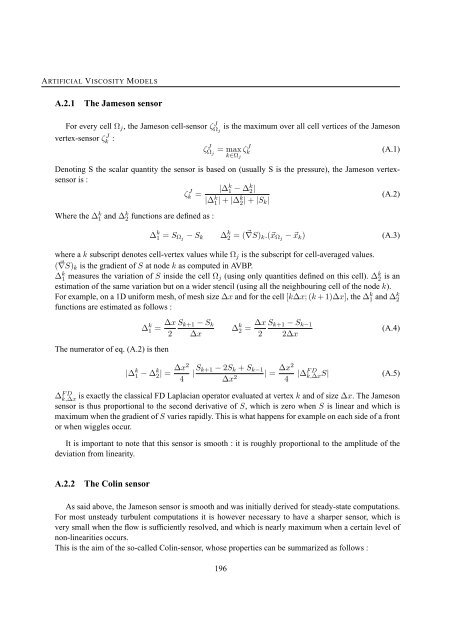these simulation numerique et modelisation de l'ecoulement autour ...
these simulation numerique et modelisation de l'ecoulement autour ...
these simulation numerique et modelisation de l'ecoulement autour ...
Create successful ePaper yourself
Turn your PDF publications into a flip-book with our unique Google optimized e-Paper software.
ARTIFICIAL VISCOSITY MODELS<br />
A.2.1<br />
The Jameson sensor<br />
For every cell Ω j , the Jameson cell-sensor ζ J Ω j<br />
is the maximum over all cell vertices of the Jameson<br />
vertex-sensor ζ J k :<br />
ζ J Ω j<br />
= max<br />
k∈Ω j<br />
ζ J k<br />
(A.1)<br />
Denoting S the scalar quantity the sensor is based on (usually S is the pressure), the Jameson vertexsensor<br />
is :<br />
ζk J |∆ k 1<br />
=<br />
− ∆k 2 |<br />
|∆ k 1 | + |∆k 2 | + |S (A.2)<br />
k|<br />
Where the ∆ k 1 and ∆k 2 functions are <strong>de</strong>fined as :<br />
∆ k 1 = S Ωj − S k ∆ k 2 = ( ⃗ ∇S) k .(⃗x Ωj − ⃗x k ) (A.3)<br />
where a k subscript <strong>de</strong>notes cell-vertex values while Ω j is the subscript for cell-averaged values.<br />
( ∇S) ⃗ k is the gradient of S at no<strong>de</strong> k as computed in AVBP.<br />
∆ k 1 measures the variation of S insi<strong>de</strong> the cell Ω j (using only quantities <strong>de</strong>fined on this cell). ∆ k 2 is an<br />
estimation of the same variation but on a wi<strong>de</strong>r stencil (using all the neighbouring cell of the no<strong>de</strong> k).<br />
For example, on a 1D uniform mesh, of mesh size ∆x and for the cell [k∆x; (k + 1)∆x], the ∆ k 1 and ∆k 2<br />
functions are estimated as follows :<br />
The numerator of eq. (A.2) is then<br />
∆ k 1 = ∆x S k+1 − S k<br />
2 ∆x<br />
∆ k 2 = ∆x S k+1 − S k−1<br />
2 2∆x<br />
(A.4)<br />
|∆ k 1 − ∆ k 2| = ∆x2<br />
4<br />
| S k+1 − 2S k + S k−1<br />
∆x 2 | = ∆x2<br />
4<br />
|∆ F D<br />
k,∆xS|<br />
(A.5)<br />
is exactly the classical FD Laplacian operator evaluated at vertex k and of size ∆x. The Jameson<br />
sensor is thus proportional to the second <strong>de</strong>rivative of S, which is zero when S is linear and which is<br />
maximum when the gradient of S varies rapidly. This is what happens for example on each si<strong>de</strong> of a front<br />
or when wiggles occur.<br />
∆ F k,∆x D<br />
It is important to note that this sensor is smooth : it is roughly proportional to the amplitu<strong>de</strong> of the<br />
<strong>de</strong>viation from linearity.<br />
A.2.2<br />
The Colin sensor<br />
As said above, the Jameson sensor is smooth and was initially <strong>de</strong>rived for steady-state computations.<br />
For most unsteady turbulent computations it is however necessary to have a sharper sensor, which is<br />
very small when the flow is sufficiently resolved, and which is nearly maximum when a certain level of<br />
non-linearities occurs.<br />
This is the aim of the so-called Colin-sensor, whose properties can be summarized as follows :<br />
196

















